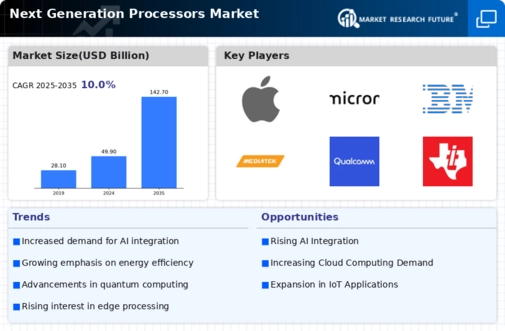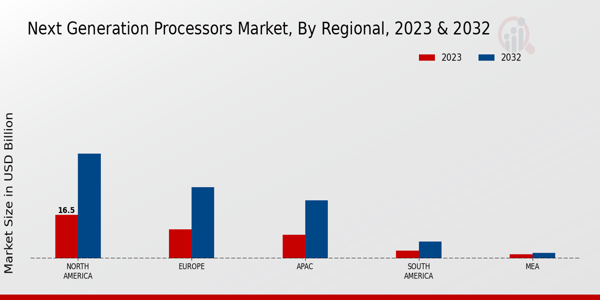Increased Adoption of Cloud Computing
The Global Next Generation Processors Market Industry is significantly influenced by the rapid adoption of cloud computing services. As businesses migrate their operations to the cloud, the demand for high-performance processors capable of supporting extensive data processing and storage requirements escalates. This shift is particularly evident in sectors such as e-commerce and digital media, where real-time data analytics is crucial. By 2035, the market is anticipated to expand to 142.7 USD Billion, underscoring the critical role of next-generation processors in facilitating cloud-based solutions and enhancing overall business agility.
Emerging Applications in Edge Computing
The rise of edge computing presents new opportunities for the Global Next Generation Processors Market Industry. By processing data closer to the source, edge computing reduces latency and bandwidth usage, which is essential for applications such as autonomous vehicles and real-time analytics. As industries seek to optimize their operations and enhance user experiences, the demand for processors that can support edge computing solutions is likely to increase. This trend aligns with the broader shift towards decentralized computing architectures, further driving innovation and investment in next-generation processor technologies.
Advancements in Semiconductor Technology
Technological advancements in semiconductor manufacturing processes significantly propel the Global Next Generation Processors Market Industry. Innovations such as 3D chip stacking, FinFET technology, and extreme ultraviolet lithography enable the production of smaller, faster, and more energy-efficient processors. These developments not only enhance performance but also reduce power consumption, which is critical in an era where energy efficiency is paramount. As a result, the market is expected to witness a compound annual growth rate of 10.03% from 2025 to 2035, reflecting the industry's commitment to continuous improvement and sustainability.
Rising Demand for AI and Machine Learning
The Global Next Generation Processors Market Industry experiences a surge in demand driven by the increasing adoption of artificial intelligence and machine learning technologies. These advanced processors are essential for handling complex algorithms and large datasets, which are pivotal in various sectors such as healthcare, finance, and automotive. As organizations seek to enhance their operational efficiency and decision-making capabilities, the market is projected to reach 49.9 USD Billion in 2024. This trend indicates a robust growth trajectory, as businesses increasingly recognize the value of integrating AI solutions into their operations.
Growing Internet of Things (IoT) Ecosystem
The proliferation of the Internet of Things (IoT) is a significant driver for the Global Next Generation Processors Market Industry. As more devices become interconnected, the need for processors that can efficiently manage and process data from these devices becomes increasingly vital. Industries such as smart home technology, industrial automation, and healthcare are leveraging IoT to enhance operational efficiency and improve user experiences. The demand for specialized processors designed for IoT applications is expected to contribute to the market's growth, reflecting the ongoing digital transformation across various sectors.























Leave a Comment